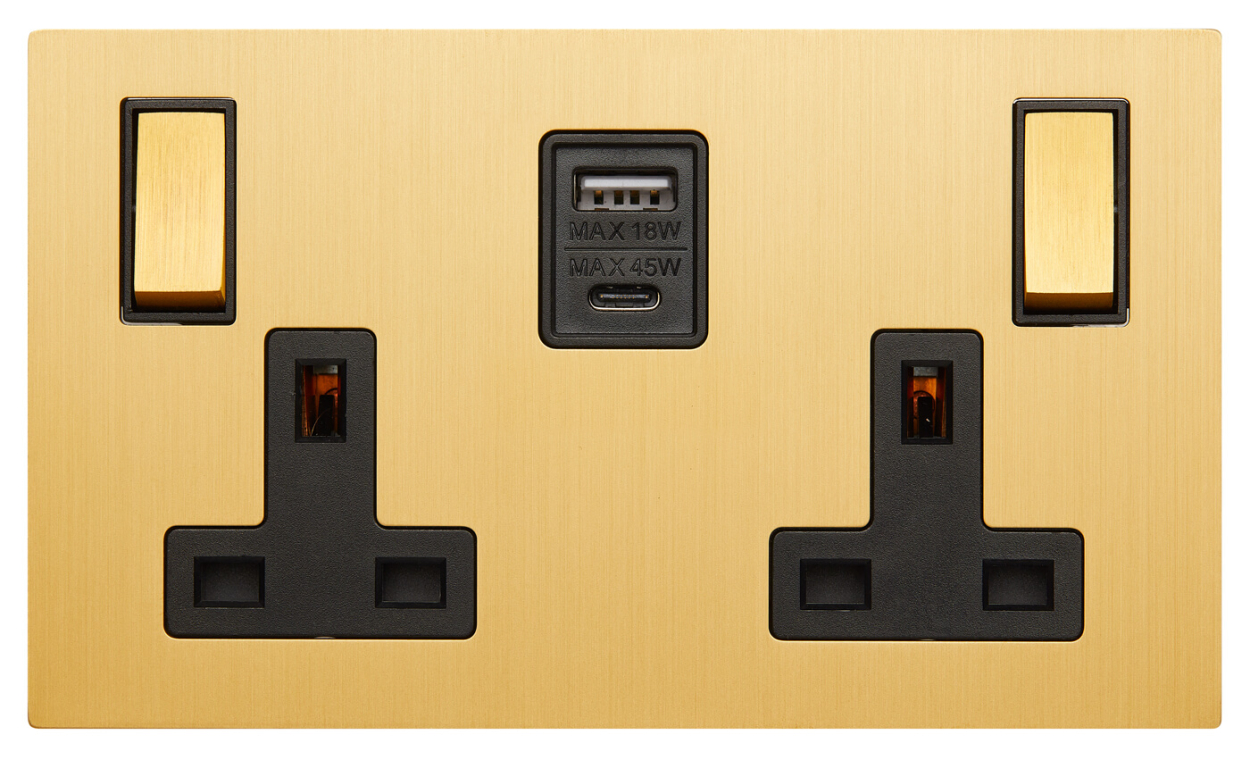Sockets with USB Power Delivery (USB PD) offer fast charging for compatible devices*

Image: Image: Renaissance in Ochre 2G 13A power delivery switched socket.
Focus SB have been at the forefront of USB integration into power outlets since 2016, our original article 'Sockets with USB - all you need to know' proved very popular and was updated a year later with ‘Looking for a socket with USB’.
However with more and more power hungry devices requiring longer charging times, fast charging is becoming more and more sought after. Recognising this, the developers of USB (USB Implementers Forum - USB-IF) developed USB Power Delivery (USB PD). It is an industry standard open specification that provides high-speed charging with variable voltage up to 20V using intelligent device negotiation up to 5A at 100W.
Focus SB twin 13amp sockets with integrated USB PD are available in Ambassador, True Edge, Morpheus and Renaissance in our standard finishes. They feature a maximum of 45 Watts or 2.25A at 20V to take advantage of the substantial increase in power delivery and charging times today.*
USB PD technical details at a glance:
The USB PD Revision 3.0 specification is a major update to enable delivering up to 240W of power over full featured USB Type-C® cable and connector. Prior to this update, USB PD was limited to 100W using a solution based on 20V using USB Type-C cables rated at 5A. The USB Type-C specification has also been updated to Release 2.1 to define 240W cable requirements, and with the updated USB PD protocol and power supply definition, this extends the applicability of USB power delivery to a large number of applications where 100W wasn't adequate.
USB Power Delivery offers the following features:
PD is short for “Power Delivery”. The technology is capable of delivering up to 100 watts of power, far more than any smartphone requires. However, this high wattage has some significant advantages. For instance, it can be used to power laptops. Apple’s new MacBooks use it and can still be used while charging. This means you’re getting much better performance than you’d expect from a standard USB cable.
In addition to 100 watt power, there are four other wattage levels: 7.5, 15, 27, and 45 watts are all supported. Within each wattage level there’s also support for various voltages. Just to use one example, in the 27-watt range, you can charge at 5, 9, or 15 volts. This makes the PD standard exceptionally versatile. Manufacturers can build a wide variety of devices, and still get top-tier performance.
In summary
In order to keep up with customer expectations and ensure a certain degree of future proofing it is important to specify USB sockets with the latest Power Delivery specification.
Power delivery product features:
- Black or white insert colour.
- Type A USB port 18W maximum output.
- Type C USB port 45W max output.
- Both ports can be used simultaneously.
- Internal fuse for overload and short circuit protection.
- Clearly marked terminal.
- Robust terminals.
- Supports all the popular charging protocols of Apple and Android
phones, tablets and laptops.
Technical specification
- Supply voltage 250V AC.
- Output combined A+C 45W.
- Type A - 5-12V 18W.
- Type C - 5V⎓3A, 9V⎓ 3A, 12V⎓2.25A, and 15V⎓1.8A.
- Output C Only 5V⎓3A, 9V⎓ 3A, 12V⎓3A, 15V⎓3A and 20V⎓2.25A.
- Protocols supported Type A APPLE 2.4A, BC1.2, AFC, FCP, and QC3.0.
- Protocols supported Type C APPLE 2.4A, BC1.2, PE2.0, AFC, FCP, SCP, QC3.0, PD3.0, and PPS.
- Standby power <0.3 Watts.
*Devices need to be USB PD compliant to take advantage of faster charging times and the list of compatible devices is growing all the time. All modern Apple devices, some Android (Samsung) and other modern devices are compliant. Some Android devices such as Samsung support the Qualcomm® Quick Charge™ 3.0 (QC3) protocol which the Focus SB charger also supports. The Focus SB charger also supports other legacy protocols. So phones with proprietary charging protocols such as Huawei, Xiaomi, One Plus, will only fast charge with their own chargers. All details are correct to our knowledge at date of publishing. Errors and Omissions Excepted (E & OE).


